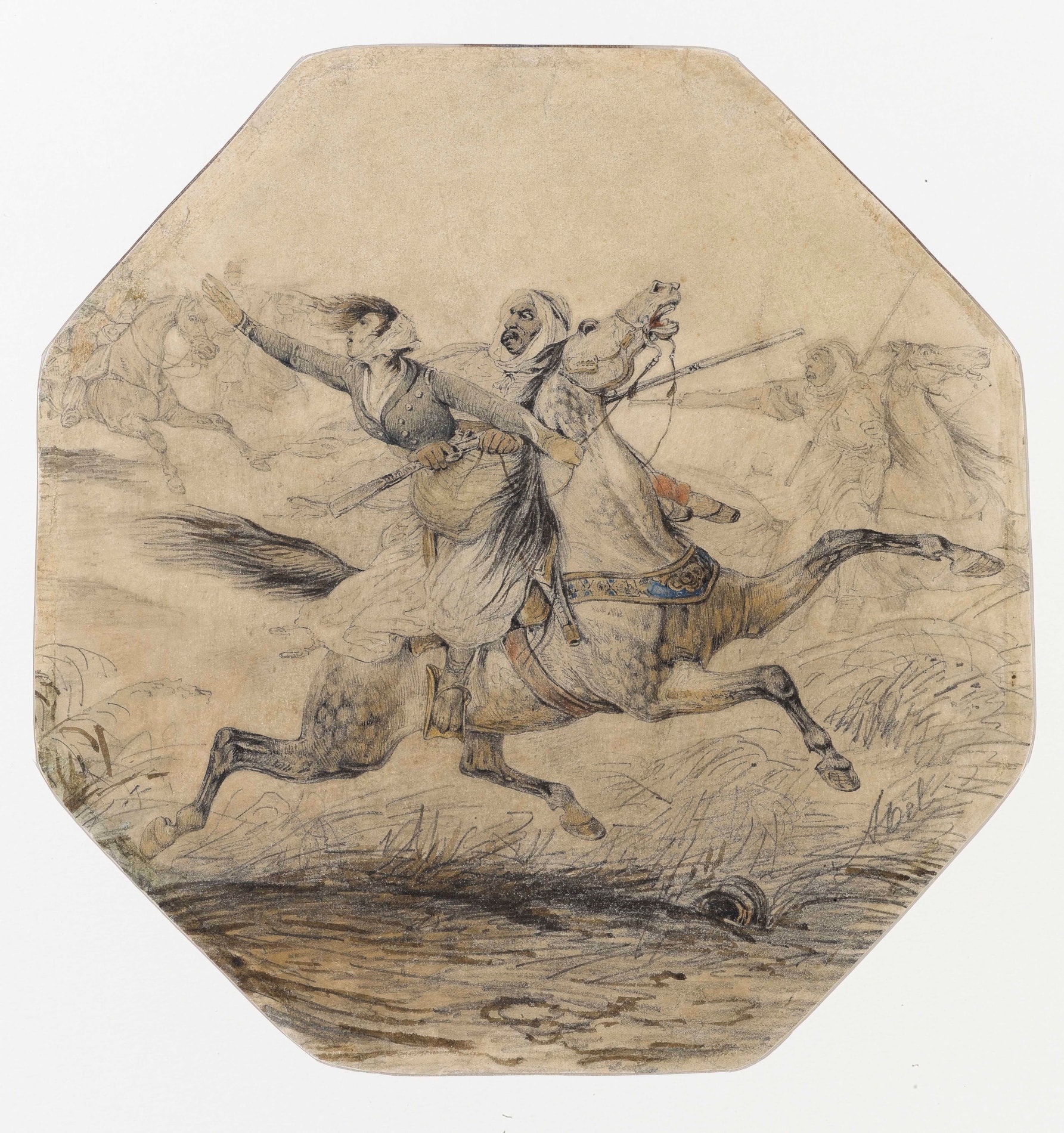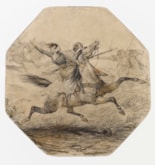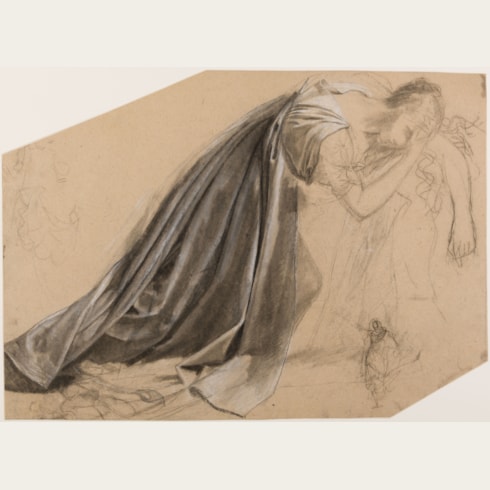Alexandre Denis ABEL DE PUJOL
(Valenciennes 1787 - Paris 1861)
A Woman Abducted by a Mounted Arab Warrior
Sold
Black chalk, brown wash and touches of watercolour.
Laid down.
Inscribed (signed?) Abel at the lower right.
Further inscribed Enlévement d’Hélène Vivandiere / au 17 Léger (chevaux Arabes) on the old backing sheet.
259 x 252 mm. (10 1/4 x 9 7/8 in.) at greatest dimensions.
Laid down.
Inscribed (signed?) Abel at the lower right.
Further inscribed Enlévement d’Hélène Vivandiere / au 17 Léger (chevaux Arabes) on the old backing sheet.
259 x 252 mm. (10 1/4 x 9 7/8 in.) at greatest dimensions.
As the inscription on the former backing sheet notes, this drawing depicts the kidnapping of a vivandière named Hélène by an Arab horseman. The term vivandière was used to refer to camp-followers; women who accompanied the army into battle, serving mainly as cooks, laundresses and nurses. The present sheet, stylistically reminiscent of the work of Abel de Pujol’s contemporaries Horace (1789-1863) and Carle Vernet (1758-1836), was until recently mounted and used as a handheld fan.
The illegitimate son and only child of the nobleman Alexander-Denis-Joseph Mortry de Pujol, Baron de la Grave – a powerful figure who served as advisor to the King and was the founder of the Académie de Peinture et Sculpture in Valenciennes - Alexandre-Denis Abel studied there from the age of twelve, before completing his training in the studio of Jacques-Louis David in Paris. He also took classes in anatomy, perspective and architecture at the Ecole des Beaux-Arts. (He received little support from his father, however, and at one point almost had to leave David’s studio as he could not afford the monthly tuition fee of twelve francs, which the master offered to pay for him, although he eventually earned a pension from Valenciennes which allowed him to continue his studies.) Abel won a first-class medal at the Académie in 1806 and a second-class medal at the Salon of 1810 for a painting of Jacob Blessing the Children of Joseph, and the same year came second in the Prix de Rome competition. The following year he won the Prix de Rome with a painting of Lycurgus Presenting the Heir to the Throne to the Lacedaemonians, after which he was formally recognized by his father and was able to add the name Pujol to his own.
As a result of poor health, as well as apparent homesickness and depression, Abel de Pujol was only able to study in Italy for eight months in 1812. Nevertheless, he resumed his career in Paris with much success, exhibiting mainly history paintings at the Salons between 1808 and 1855. A large and ambitious painting of The Death of Britannicus won gold medals from both Louis XVIII and Napoleon in 1814, while a grisaille painting of The Preaching and Martyrdom of Saint Stephen, intended for the church of Saint-Etienne-du-Mont, was equally admired at the Salon of 1817, winning the prize for history painting and firmly establishing the artist’s reputation. He received a number of important official commissions, including three paintings for Versailles and a ceiling painting for the Palais Royal, as well as a large allegorical ceiling painting of The Renaissance of the Arts for the grand staircase of the Louvre, which was sadly destroyed in 1855. Abel de Pujol continued to be in great demand as a painter of mural decorations for public buildings, such as the main hall of the Bourse, the Musée Charles X of the Palais du Louvre, the Galerie de Diane at Fontainebleau, the Palais de Luxembourg and elsewhere. He was particularly admired as a painter of large-scale grisaille decorations; of his work at the Bourse, the critic Charles Blanc noted, ‘The grisailles which decorate the Paris Bourse, and in which the artist has imitated in trompe-l'oeil the projections and hollows of a series of bas-reliefs, bear witness to a skill that cannot be praised too highly…Abel de Pujol has shown all that he possesses, the science of the nude, the talent for modelling, the art of drapery; and, in confining himself to painting this vast decoration in monochrome, he has shown himself to be a man of spirit.’
Throughout his career, Abel de Pujol produced paintings and murals, many in grisaille, as well as altarpieces and designs for stained-glass windows for several Parisian churches, notably at Saint-Sulpice, Notre-Dame-de-Bonne-Nouvelle, Saint-Roch, Saint-Denis-du-Saint-Sacrement, Saint-Thomas d’Acquin and the Madeleine. He also worked in the cathedral at Arras and the church of Saint-Pierre in Douai. In 1846 he was commissioned to paint a monumental canvas of Valenciennes Encouraging the Arts for the town hall of Valenciennes, and in 1852 painted the ceiling of the staircase of the Ecole des Mines at the Hôtel de Vendôme in Paris, which was to be one of his last major decorative schemes. Admitted into the Legion of Honour in 1822 and the Académie des Beaux-Arts in 1835, Abel de Pujol also produced a handful of portraits, mainly of family and friends. He was a popular and successful teacher, and counted among his pupils Alexandre-Gabriel Decamps, Pierre-Justin Ouvrié and Camille Rocqueplan. As a draughtsman, Abel de Pujol was much admired in his lifetime by critics and connoisseurs. The largest extant collection of the artist’s drawings, amounting to almost 150 sheets, is today in the collection of the Musée des Beaux-Arts in Valenciennes.
As a result of poor health, as well as apparent homesickness and depression, Abel de Pujol was only able to study in Italy for eight months in 1812. Nevertheless, he resumed his career in Paris with much success, exhibiting mainly history paintings at the Salons between 1808 and 1855. A large and ambitious painting of The Death of Britannicus won gold medals from both Louis XVIII and Napoleon in 1814, while a grisaille painting of The Preaching and Martyrdom of Saint Stephen, intended for the church of Saint-Etienne-du-Mont, was equally admired at the Salon of 1817, winning the prize for history painting and firmly establishing the artist’s reputation. He received a number of important official commissions, including three paintings for Versailles and a ceiling painting for the Palais Royal, as well as a large allegorical ceiling painting of The Renaissance of the Arts for the grand staircase of the Louvre, which was sadly destroyed in 1855. Abel de Pujol continued to be in great demand as a painter of mural decorations for public buildings, such as the main hall of the Bourse, the Musée Charles X of the Palais du Louvre, the Galerie de Diane at Fontainebleau, the Palais de Luxembourg and elsewhere. He was particularly admired as a painter of large-scale grisaille decorations; of his work at the Bourse, the critic Charles Blanc noted, ‘The grisailles which decorate the Paris Bourse, and in which the artist has imitated in trompe-l'oeil the projections and hollows of a series of bas-reliefs, bear witness to a skill that cannot be praised too highly…Abel de Pujol has shown all that he possesses, the science of the nude, the talent for modelling, the art of drapery; and, in confining himself to painting this vast decoration in monochrome, he has shown himself to be a man of spirit.’
Throughout his career, Abel de Pujol produced paintings and murals, many in grisaille, as well as altarpieces and designs for stained-glass windows for several Parisian churches, notably at Saint-Sulpice, Notre-Dame-de-Bonne-Nouvelle, Saint-Roch, Saint-Denis-du-Saint-Sacrement, Saint-Thomas d’Acquin and the Madeleine. He also worked in the cathedral at Arras and the church of Saint-Pierre in Douai. In 1846 he was commissioned to paint a monumental canvas of Valenciennes Encouraging the Arts for the town hall of Valenciennes, and in 1852 painted the ceiling of the staircase of the Ecole des Mines at the Hôtel de Vendôme in Paris, which was to be one of his last major decorative schemes. Admitted into the Legion of Honour in 1822 and the Académie des Beaux-Arts in 1835, Abel de Pujol also produced a handful of portraits, mainly of family and friends. He was a popular and successful teacher, and counted among his pupils Alexandre-Gabriel Decamps, Pierre-Justin Ouvrié and Camille Rocqueplan. As a draughtsman, Abel de Pujol was much admired in his lifetime by critics and connoisseurs. The largest extant collection of the artist’s drawings, amounting to almost 150 sheets, is today in the collection of the Musée des Beaux-Arts in Valenciennes.






